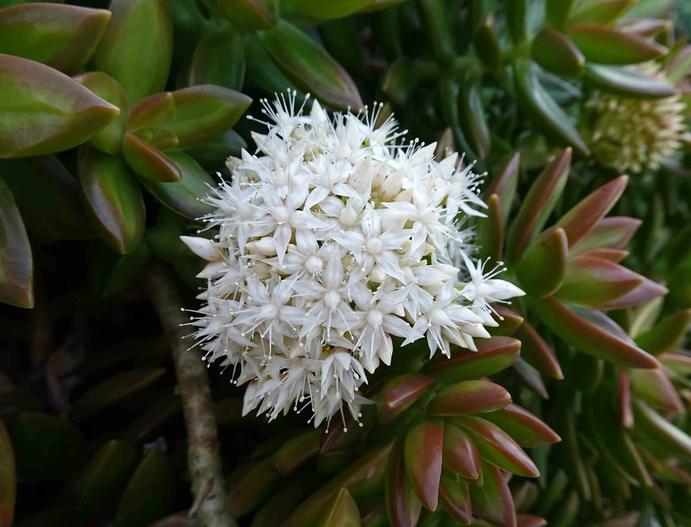Coppertone Stonecrop
(Sedum nussbaumerianum)
Coppertone Stonecrop (Sedum nussbaumerianum)
/
/

阿橋花譜 HQ Flower Guide
CC BY-SA 2.0
Image By:
阿橋花譜 HQ Flower Guide
Recorded By:
Copyright:
CC BY-SA 2.0
Copyright Notice:
Photo by: 阿橋花譜 HQ Flower Guide | License Type: CC BY-SA 2.0 | License URL: https://creativecommons.org/licenses/by-sa/2.0/ | Uploader: 阿橋 KHQ | Publisher: Flickr




















Estimated Native Range
Summary
Sedum nussbaumerianum, commonly known as Coppertone Stonecrop, is an evergreen succulent native to the rocky outcrops and slopes in the states of Veracruz and Oaxaca in Mexico. It typically grows up to 8 inches (20 cm) tall and wide, forming rosettes of fleshy, pointed leaves that turn a striking copper-orange hue when exposed to bright sunlight. The small, star-shaped white flowers bloom in late winter to spring, adding to its ornamental value. Coppertone Stonecrop is particularly noted for its ease of propagation and its vibrant foliage color, which intensifies with more sun exposure.
Coppertone Stonecrop is a popular choice for rock gardens, containers, and as ground cover due to its low maintenance and drought tolerance. It thrives in full sun to part shade and requires very little water once established, making it an ideal plant for xeriscaping. It prefers well-draining soil and is hardy in USDA zone 9 and southward. While it can be propagated by cuttings, leaves, or seeds, it is most commonly propagated by cuttings for quicker establishment. Potential problems include root rot if overwatered and mealybugs or aphids. It is not known to be invasive and can be a charming addition to any succulent collection or drought-tolerant landscape.CC BY-SA 4.0
Coppertone Stonecrop is a popular choice for rock gardens, containers, and as ground cover due to its low maintenance and drought tolerance. It thrives in full sun to part shade and requires very little water once established, making it an ideal plant for xeriscaping. It prefers well-draining soil and is hardy in USDA zone 9 and southward. While it can be propagated by cuttings, leaves, or seeds, it is most commonly propagated by cuttings for quicker establishment. Potential problems include root rot if overwatered and mealybugs or aphids. It is not known to be invasive and can be a charming addition to any succulent collection or drought-tolerant landscape.CC BY-SA 4.0
Plant Description
- Plant Type: Subshrub, Succulent
- Height: 0.3-0.7 feet
- Width: 0.429-1 feet
- Growth Rate: Moderate
- Flower Color: White
- Flowering Season: Spring
- Leaf Retention: Evergreen
Growth Requirements
- Sun: Full Sun, Part Shade
- Water: Very Low, Low
- Drainage: Medium, Fast
Common Uses
Bee Garden, Bird Garden, Border Plant, Butterfly Garden, Deer Resistant, Drought Tolerant, Fire Resistant, Groundcover, Hummingbird Garden, Low Maintenance, Potted Plant, Rabbit Resistant, Rock Garden, Showy Flowers, Street Planting
Natural Habitat
Rocky outcrops and slopes in Veracruz and Oaxaca, Mexico
Other Names
Common Names:
Scientific Names: , Sedum nussbaumerianum, Sedum adolphi,
GBIF Accepted Name: Sedum nussbaumerianum Bitter